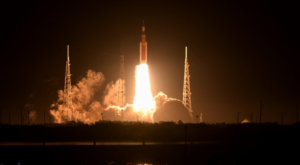NASA’s new era of deep space exploration has begun.
With a mighty roar, the most powerful NASA rocket ever built — the Space Launch System (SLS) — soared into the Florida early morning sky on the Artemis 1 mission, a risky and long-delayed test flight to send a next-generation space capsule to the moon and back. Liftoff occurred today (Nov. 16) at 1:47 a.m. EST (0647 GMT) from NASA’s Pad 39B here at Kennedy Space Center (KSC) in Florida.
Artemis 1 is sending NASA’s new Orion spacecraft on an uncrewed test flight around the moon. This shakedown mission, NASA’s first flight of a crew-capable moon ship in nearly 50 years, serves as the proving ground to see if SLS and Orion are ready to help return astronauts to the lunar surface by 2025 under NASA’s Artemis program.
“Liftoff of Artemis 1!” NASA commentator Derrol Nail said during the webcast of this morning’s launch. “We rise together, back to the moon and beyond.”
We are going.
For the first time, the @NASA_SLS rocket and @NASA_Orion fly together. #Artemis I begins a new chapter in human lunar exploration. pic.twitter.com/vmC64Qgft9
— NASA (@NASA) November 16, 2022
NASA’s Artemis I mission has taken off from Kennedy Space Center. The uncrewed mission will test technology NASA hopes to use to return astronauts to the moon. https://t.co/PACyZSVSld pic.twitter.com/Vmrw59yPC6
— CNN (@CNN) November 16, 2022
A few minutes later, Artemis launch director Charlie Blackwell-Thompson addressed her team at mission control.
“This is your moment,” she said. “We are all part of something incredibly special: The first launch of Artemis, the first step in returning our country to the moon and on to Mars. What you have done today will inspire generations to come.”
Read more: Space
Ask me anything
Explore related questions





